On This Page
What Does a Domestic Mallard Look Like?
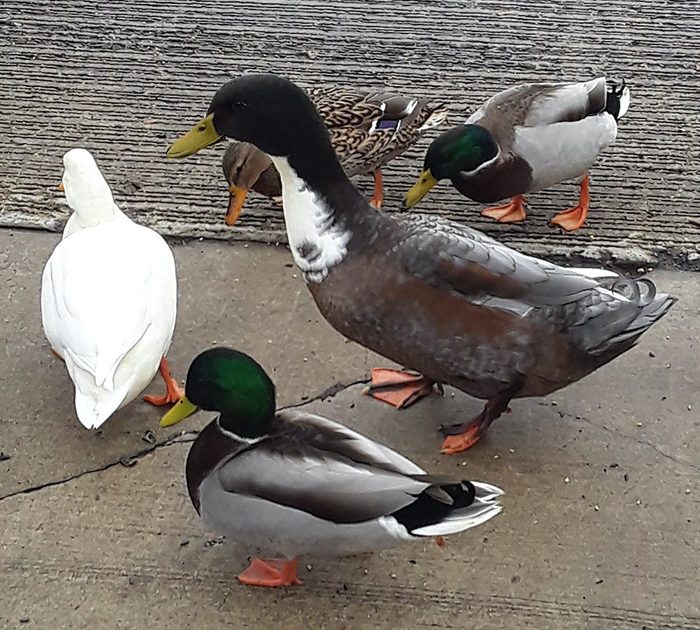
“This large duck hangs out with mallards but looks completely different. What is it?” asks Birds & Blooms reader Todd Gorski of Mishawaka, Indiana.
Birding experts Kenn and Kimberly Kaufman say, “Most domestic ducks are descended from the mallard, first domesticated in the Far East more than 2,500 years ago. Many distinctive forms have been selectively bred for new colors and sizes. These are not separate domestic duck species, just different varieties, much like there are many breeds of dogs. These varieties all interbreed with each other, producing intermediates.
More than 80 mallard varieties have been named. Some are large and dark with a white bib, such as the bird in your photos. Your bird doesn’t seem like an exact match for any named breed, but it’s similar to both Duclair and Blue Swedish ducks.”
What foods can you feed to ducks?
Escaped Domestic Ducks
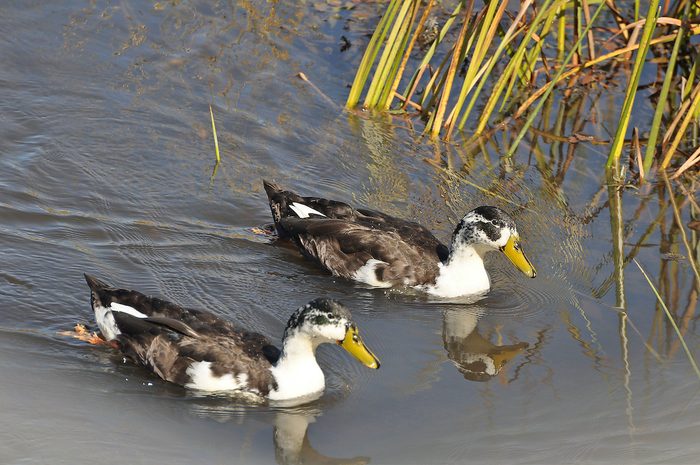
“We saw these ducks (above) while at the Sacramento National Wildlife Refuge Complex last October. What kind are they?” asks Roy and Debbie Pardee of Ukiah, Connecticut.
Kenn and Kimberly say, “The short answer is that these are escaped domestic ducks, but the long answer is more interesting. Most domestic ducks are descended from either mallards or Muscovy ducks, and those in your photo are in the mallard line. Over the last several centuries, people have developed many distinctive breeds of these ducks, ranging from all white to glossy greenish black, and many colors in between.
These two look most similar to a rare breed called the Ancona duck, but they are not completely typical. When domestic ducks escape from captivity, they may wander in the wild for years, causing confusion for bird watchers.”
Meet 20 types of ducks you should know.
Are These White Mallard Ducks Leucistic?

“I saw these ducks while in Gilbert, Arizona. I think they’re leucistic mallards, but my dad thinks they’re a different species. What are they?” asks reader Elsa Papenfuss of Star, Idaho.
Kenn and Kimberly say, “Mallards have been domesticated for more than 2,000 years, and many distinct breeds have been developed during that time. These are not separate species, just varieties, comparable to dog breeds like poodles or beagles. More than 80 varieties of domestic mallards have been recognized and named, and because they can all interbreed with each other, they produce many intermediate forms. The birds in your photo look similar to a couple of types called Blue Swedish and Ancona, although these ducks aren’t quite typical for either.”
Domestic White Crested Duck
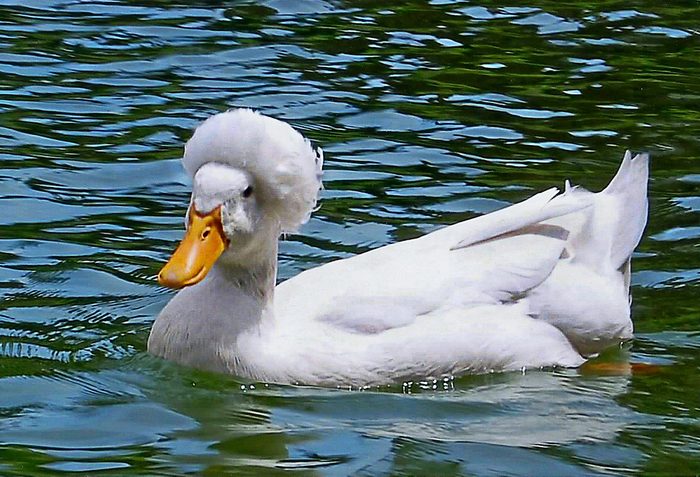
“This photo was taken at a lake in Columbus, Ohio. Can you tell me what kind of duck this is?” asks reader Georgette Ingellis of Bristol, Connecticut.
Kenn and Kimberly say, “Over the centuries, waterfowl breeders have developed many distinctive varieties of domestic ducks, with almost all of them descended from the familiar mallard. This attractive breed is called a white crested duck. It has been a recognized variety for more than 300 years, with ducks of this type seen in Dutch paintings of the 1660s. Like other domestic duck breeds, white cresteds are sometimes seen wandering around in the wild or visiting park lakes.”
Learn how to identify a wood duck.
Domestic Hybrid Canada Goose
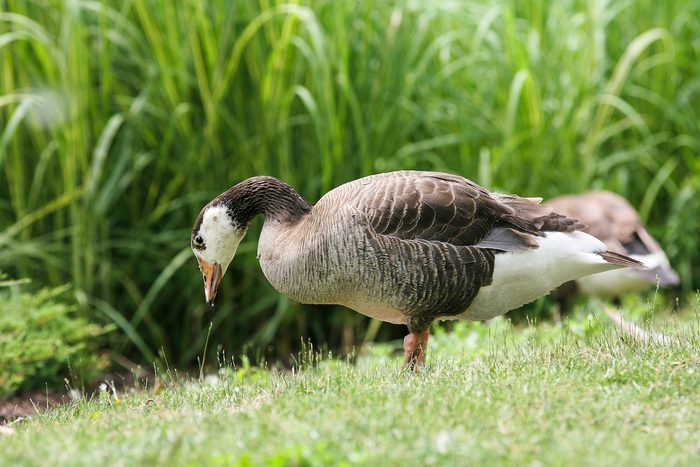
“I saw this goose in a group of Canada geese and noticed that it was different. What kind is it?” asks reader John Yinger of Columbus, Ohio.
Kenn and Kimberly say, “Interesting goose! It looks like a hybrid—a cross between a Canada goose and a domestic greylag goose. This kind of thing happens occasionally, because geese are not always very picky in mating season. Canada geese are often involved in these mixed pairings. The trick is to figure out the identity of the other parent. For the bird in your photo, the overall body color, large pinkish bill and heavy rear end all suggest that a domestic greylag was the other member of the pair.”
Next, learn how to tell the difference between a canvasback vs a redhead duck.
Why Trust Us
For nearly 30 years, Birds & Blooms, a Trusted Media Brand, has been inspiring readers to have a lifelong love of birding, gardening and nature. We are the #1 bird and garden magazine in North America and a trusted online resource for over 15 million outdoor enthusiasts annually. Our library of thousands of informative articles and how-tos has been written by trusted journalists and fact-checked by bird and garden experts for accuracy. In addition to our staff of experienced gardeners and bird-watchers, we hire individuals who have years of education and hands-on experience with birding, bird feeding, gardening, butterflies, bugs and more. Learn more about Birds & Blooms, our field editor program, and our submission guidelines.
On This Page
Forsythia Bush Growing Tips
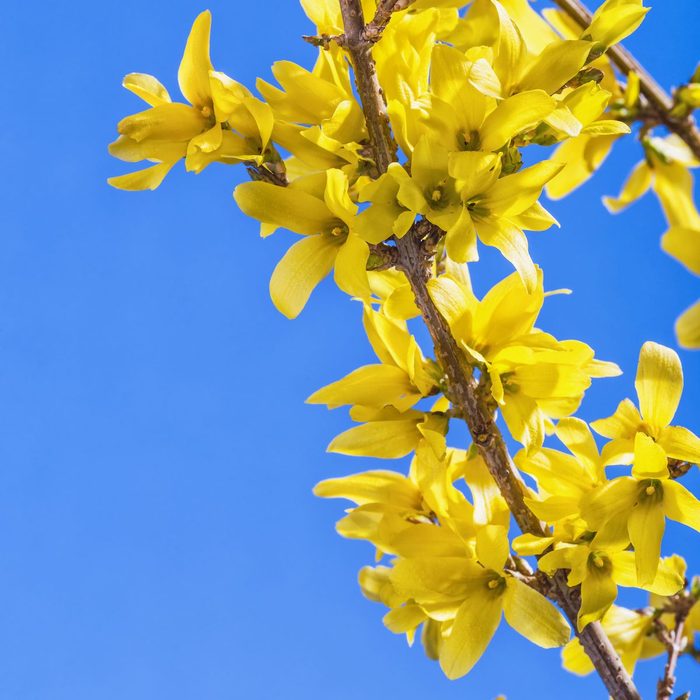
- Common name: Forsythia
- Scientific name: Forsythia spp.
- Zones: 4 to 8
- Light needs: Full sun
- Size: 8 to 10 feet high; dwarf varieties are available
- Grown for: Sunny yellow flowers
- Foliage: Dark green leaves
When a forsythia bush (Forsythia spp.) blooms, it’s a sure sign that warmer weather is on the way. Forsythia is one of the earliest bushes to bloom in spring, making its bell-shaped golden flowers a welcome sight.
Forsythia is a fast-growing, large shrub that thrives in Zones 4 to 8. (Here’s how to find your plant zone). It will grow to be 8 to 10 feet high, though there are dwarf varieties available and it can be pruned for size. Give this plant a try as a hedge that’ll put on a spectacular show in the spring.
For best results, grow forsythia in well-drained soil with regular moisture and in full sun to part shade.
When Does Forsythia Bloom?
Forsythia can bloom as early as late January or early February in warmer zones. It’ll bloom through late March in colder zones. The sunny yellow blooms last for 10 to 14 days. After the flowers fade, dark green leaves emerge.
Blooms develop in late summer and early fall for the following year, so the shrub should be pruned immediately after flowering in the spring for best results.
Check out the top 10 flowering bushes for your yard.
Forsythia Bird Benefits
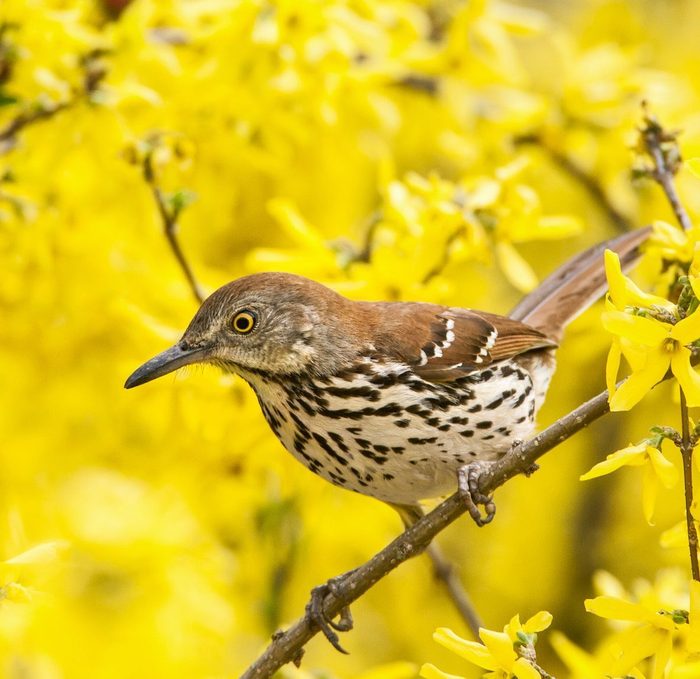
Place seed feeders near forsythia and other shrubs so birds can wait their turn for a snack or safely hide from backyard predators.
Check out the top 10 trees and shrubs with berries for birds.
Why Is My Forsythia Bush Not Blooming?
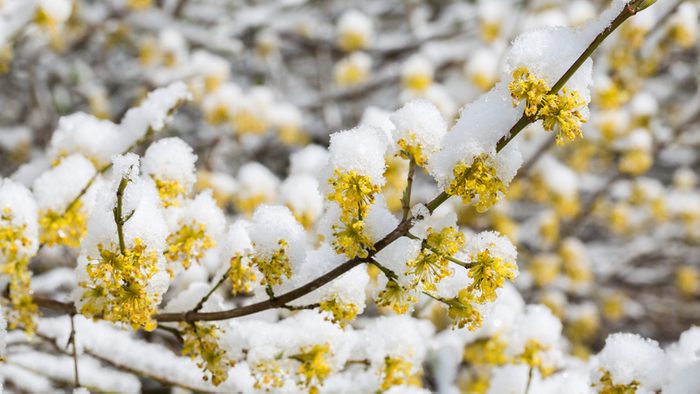
“My forsythia had flowers for the past two years, but only on the bottom of the shrub. What’s wrong with it?” asks Birds & Blooms reader Janet Grosse of Madison, Wisconsin.
Horticultural expert Melinda Myers weighs in: “This is a common problem for those of us growing forsythia in colder climates. Even though the plant tolerates the winter cold, the dormant flower buds that form during the previous summer are often killed.”
Melinda has recommendations for cold-hardy cultivars that’ll thrive in areas with more intense winters: “In the future, select forsythia cultivars, such as Northern Sun, Show Off Starlet, Gold Cluster or Fiesta. They all have hardy flower buds that can withstand colder weather,” she says.
You can try other cultivars to fit your needs, too. Northern Gold is an upright grower and Meadowlark is fast-growing with an arching form. For a cultivar that’ll thrive in warmer climates, opt for Spring Glory.
Forsythia Bush Facts
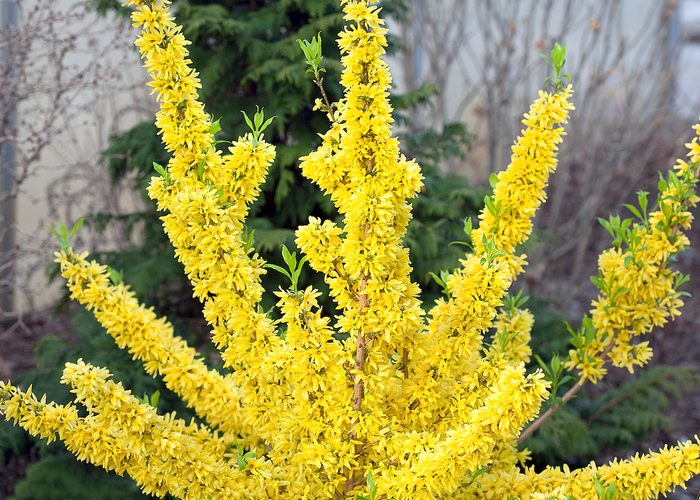
- Originally called Syringa suspensa, the first identified forsythia species was renamed after Scottish botanist William Forsyth in 1804.
- Ready to make a statement? Meadowlark forsythia can reach up to 10 feet high if unpruned.
- All varieties of forsythia share the same characteristic four petals.
- Forsythia flower buds begin to drop if temperatures hit minus 5 degrees. Look for “flower-bud hardy” types for the most reliable flowering in colder areas.
- There are about 11 species in the Forsythia genus, which falls under the olive family, or Oleaceae. They all hail from Asia except for one from Europe.
- Like lilacs and crabapples, forsythia branches will flower early in a vase indoors—for an average of two weeks—if cut while budding.
Additional reporting by Erica Browne Grivas
Reviewed by horticultural expert Melinda Myers
Why Trust Us
For nearly 30 years, Birds & Blooms, a Trusted Media Brand, has been inspiring readers to have a lifelong love of birding, gardening and nature. We are the #1 bird and garden magazine in North America and a trusted online resource for over 15 million outdoor enthusiasts annually. Our library of thousands of informative articles and how-tos has been written by trusted journalists and fact-checked by bird and garden experts for accuracy. In addition to our staff of experienced gardeners and bird-watchers, we hire individuals who have years of education and hands-on experience with birding, bird feeding, gardening, butterflies, bugs and more. Learn more about Birds & Blooms, our field editor program, and our submission guidelines.
Sources
- University of Oxford
- Missouri Botanical Garden
- University of Wisconsin-Madison Division of Extension
- The Royal Horticulture Society
- North Carolina Cooperative Extension
How to Stop a Bird From Pecking at a Window
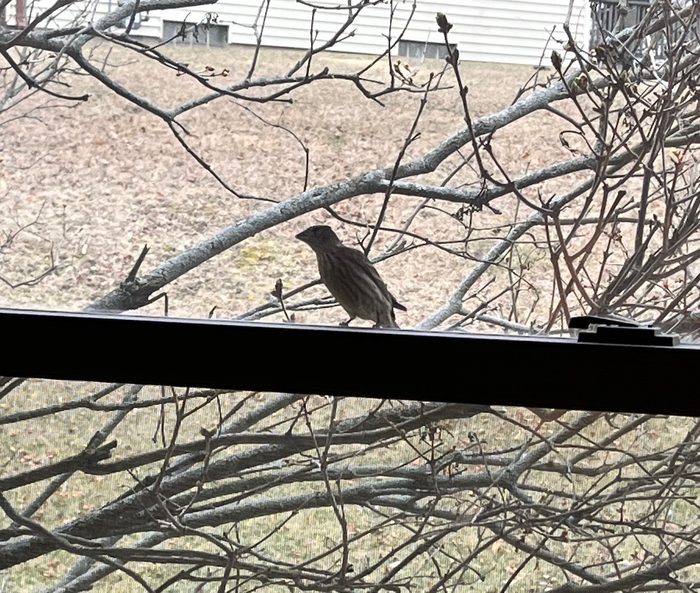
“A cardinal is pecking at my window constantly. How do I make it stop?” asks Birds & Blooms reader Kay Baker of Mercer, Pennsylvania.
Birding experts Kenn and Kimberly Kaufman say, “When a bird starts pecking at a window like that, it has mistaken its own reflection for another bird and is trying to drive it away. Some individuals become obsessed with these phantom rivals and may attack them for weeks.
The only real solution is to do away with the reflection itself. You need to block the reflection on the outside of the glass. Putting an exterior screen on the window is one simple solution. If that isn’t possible, try rubbing a bar of soap on the outside of your windows in all the spots that the bird visits regularly. Or tape a piece of paper or plastic over those areas. If none of those options are feasible, you can just wait.
The cardinal should lose its drive to defend its territory after the breeding season wanes. Even if you can’t block all the reflections, this behavior should end after a few weeks.”
Find out why woodpeckers peck and how to stop it.
Birds Pecking at Car Mirrors
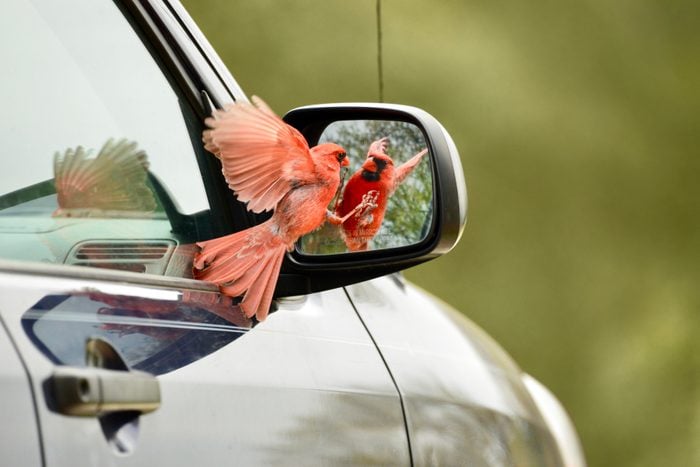
“Why do cardinals peck at my vehicle’s side mirror?” asks reader Patricia Ekakiadis of Avonmore, Pennsylvania.
Kenn and Kimberly say, “Cardinals, like many other birds, defend a territory during the nesting season to make sure they have enough space and food for themselves, their mate and their young. If a male cardinal sees another male cardinal in his territory, he chases the trespasser away.
Unfortunately, he can’t tell the difference between a real cardinal and a reflection in a mirror. So he might spend hours trying to chase away this false intruder that can’t be intimidated. You might try covering the mirror when you’re not driving your car so this defensive cardinal can go about his business.”
Are hummingbirds territorial at feeders and flowers?
About the Experts
Birding experts Kenn and Kimberly Kaufman are the duo behind the Kaufman Field Guide series and speak and lead bird trips all over the world. If you have a bird-related question for them, submit it here! It could appear here or in a future issue of the magazine.
Why Trust Us
For nearly 30 years, Birds & Blooms, a Trusted Media Brand, has been inspiring readers to have a lifelong love of birding, gardening and nature. We are the #1 bird and garden magazine in North America and a trusted online resource for over 15 million outdoor enthusiasts annually. Our library of thousands of informative articles and how-tos has been written by trusted journalists and fact-checked by bird and garden experts for accuracy. In addition to our staff of experienced gardeners and bird-watchers, we hire individuals who have years of education and hands-on experience with birding, bird feeding, gardening, butterflies, bugs and more. Learn more about Birds & Blooms, our field editor program, and our submission guidelines.
On This Page
What Does a Rivoli’s Hummingbird Look Like?
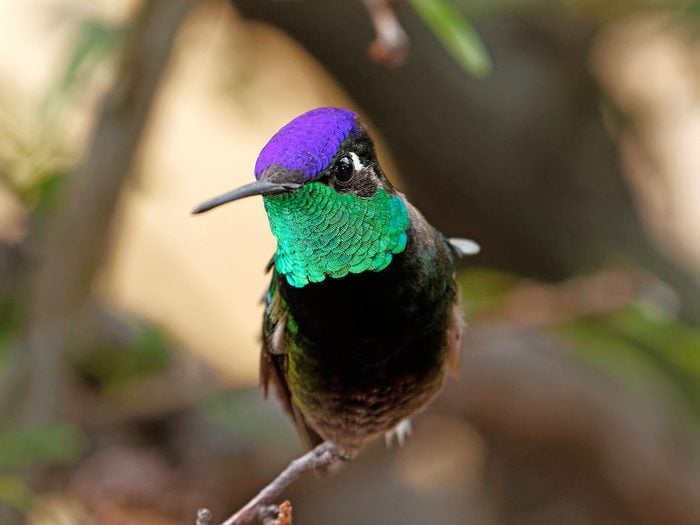
An adult male Rivoli’s hummingbird has that classic hummingbird shimmer, but they’re even more dazzling than many of the other types of hummingbirds in the United States. A teal green gorget and purplish feathers on the crowns of their heads are a surefire way to identify a male. The feathers on his back might appear black, but take a closer look—they’re an iridescent dark green.
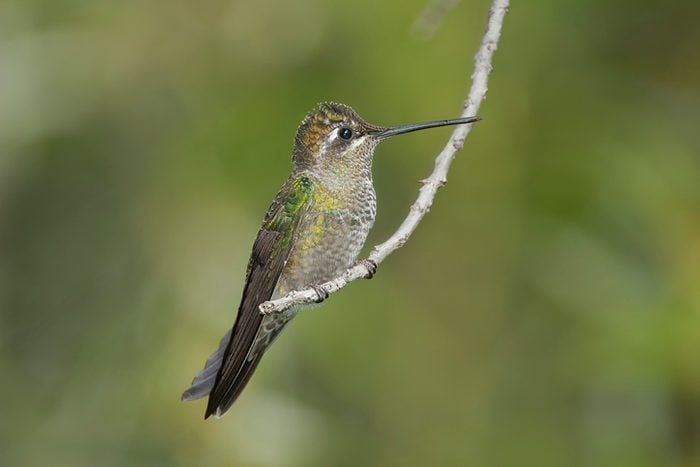
Telling a female Rivoli’s apart from other species is a bit trickier. At first glance, she bears a close resemblance to several other juvenile or female hummingbirds. Take note of the second, defined white stripe branching from her bill to the area just below her eye and the green feathers on her back as keys to correctly identify her.
Another easy way to differentiate between Rivoli’s and many other hummingbird species is to note their size. Of identifying a Rivoli’s, Audubon Southwest’s Director of Conservation Tice Supplee says, “The first clue is ‘He’s big!'” She explains that a Rivoli’s hummingbird is about three times the size of a black-chinned hummingbird, and two and a half times the size of a ruby-throat.
Attract hummingbirds to your yard with proven tips from birding experts.
Range: Where Do Rivoli’s Hummingbirds Live?
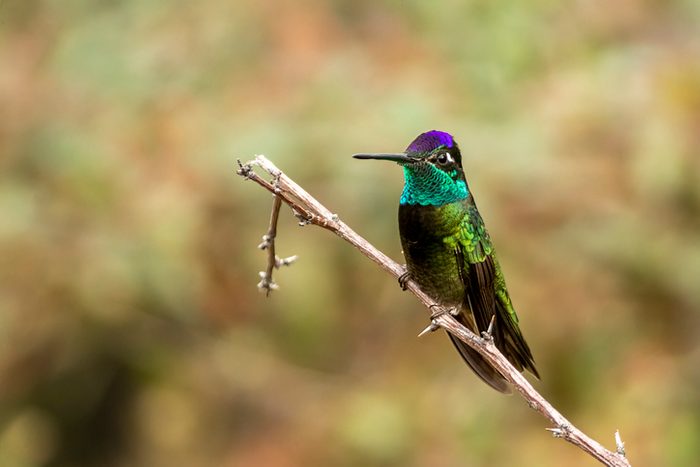
If you’re determined to spot a Rivoli’s, you’ll need to head south. These gem-colored little fliers only enter the United States during breeding season. They buzz over to mountainous areas in the Southwest, and specifically in lower Arizona and New Mexico. You might find one on the far west side of Texas during breeding season as well, but you’d have to be pretty lucky—those sightings are uncommon.
“What we have in the U.S. is a breeding population,” Tice explains. “When you get into Mexico, Costa Rica and Nicaragua, they have them year-round.” Tice also mentioned that the birds tend to migrate each year to the sky island mountain ranges in Arizona and New Mexico.
Interestingly, she also mentions their range might be expanding. “Records are starting to show up further north,” Tice says. “There’s a breeding pair now that’s reliably seen in Oak Creek Canyon in Sedona, Arizona, so that’s pretty far north.”
Rivoli’s Hummingbird Diet
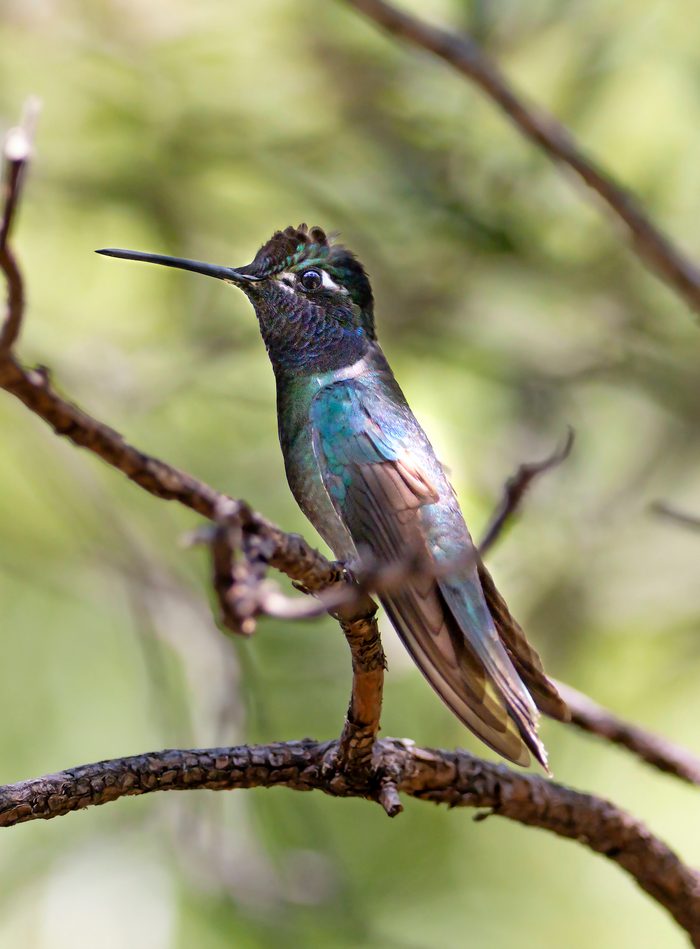
With such a limited range, Rivoli’s hummingbirds aren’t typical backyard birds. That said, those living in the area they migrate to each year might be able to bring them in. “It’ll come to hummingbird feeders,” Tice explains. “You’re not going to get them in downtown Santa Fe or Tuscon, but if you have a summer cabin on the top of the Catalinas, they’ll come to your feeders.”
Here’s how to make a perfect batch of sugar water to feed hummingbirds.
Tice also says they’ll stop by native plants such as Indian paintbrush, penstemons, and agave.
Nesting Habits
Rivoli’s nesting habits mostly remain a mystery, but Tice is able to shine some light on the subject. “They don’t nest where they feed, and they tend to nest up in canyons in pine oak woodlands of the sky islands,” she says.
Find out everything you need to know about hummingbird nests.
Sounds
Listen for a short, clipped, high-pitched call that is repeated, sometimes in rapid succession.
Bird songs courtesy of the Cornell Lab of Ornithology.
Rivoli’s Hummingbird Name Changes
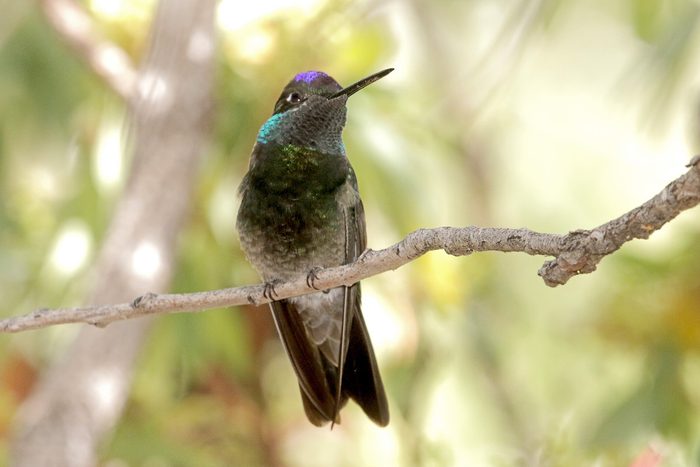
If you think the Lucifer hummingbird has a wacky name, get ready for the weirdness surrounding the Rivoli’s. Originally, the Rivoli’s hummingbird was named to honor the second duke of Rivoli. In the 1980s, the Rivoli’s hummingbird became the magnificent hummingbird (and to be fair, they are pretty magnificent looking).
But then, in 2017, the change was reversed. Certain magnificent hummingbirds again became Rivoli’s, while others were newly dubbed Talamanca hummingbirds. The easiest way to tell whether you’re looking at a Rivoli’s or a Talamanca is to pull out a map. Rivoli’s call the United States through Nicaragua home, while Talamanca hummingbirds live in in Panama and Costa Rica.
Given that the American Ornithological Society is renaming all birds named after people, it’s likely the Rivoli’s hummingbird will get another new name in the near future.
About The Expert
- Vashti “Tice” Supplee is Audubon Southwest‘s Director of Bird Conservation. Throughout her career she has worked in research, habitat management, urban wildlife, and game management. At Audubon, she coordinates science-related activities with the National Audubon Society and serves as co-manager of the Arizona Important Bird Areas program.
Sources
- Cornell Lab of Ornithology: “Rivoli’s Hummingbird
- Tuscon Audubon: “Rivoli’s Hummingbird”
Why Trust Us
For nearly 30 years, Birds & Blooms, a Trusted Media Brand, has been inspiring readers to have a lifelong love of birding, gardening and nature. We are the #1 bird and garden magazine in North America and a trusted online resource for over 15 million outdoor enthusiasts annually. Our library of thousands of informative articles and how-tos has been written by trusted journalists and fact-checked by bird and garden experts for accuracy. In addition to our staff of experienced gardeners and bird-watchers, we hire individuals who have years of education and hands-on experience with birding, bird feeding, gardening, butterflies, bugs and more. Learn more about Birds & Blooms, our field editor program, and our submission guidelines.
On This Page
Why Purple Martins Need Birdhouses
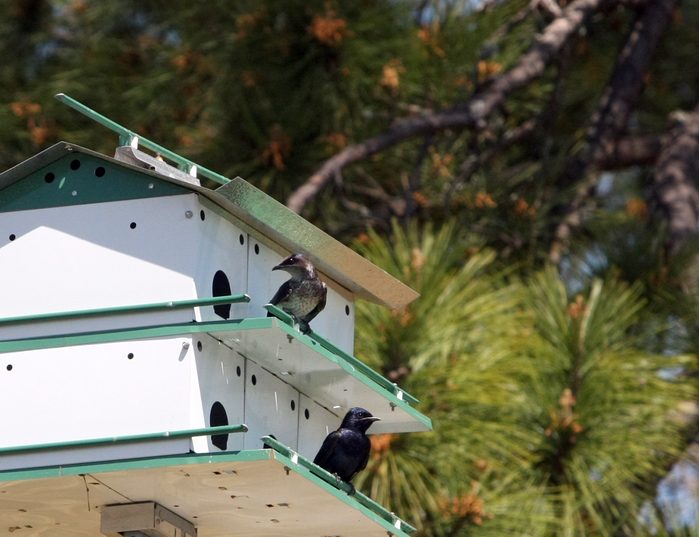
Historically, purple martins nested in natural tree hollows, old woodpecker holes, and cliff crevices near water throughout most of the U.S. The birds continue to do so in the West, especially in saguaro cacti. But in the eastern half of the country, purple martins now nest almost exclusively in manmade boxes. Native Americans began the tradition thousands of years ago when they found that a hollow gourd placed in a tree was attractive to breeding bird pairs. Man-made purple martin houses are now essential to martins’ survival.
An estimated 1 million purple martin landlords listen each spring for the chortling call of their summer tenants reappearing from the south. Martins can often be heard calling as they glide above forested areas in an attempt to attract younger adults to the colony. In summer, purple martin houses across the country are filled with adults ready to raise their young.
Learn to identify 8 types of swallows.
How to Choose a Purple Martin House
“I’m new to attracting purple martins. Can you give me some guidance on choosing and setting up a birdhouse?” asks Birds & Blooms reader Cindy Phelps of Louisburg, North Carolina.
Birding experts Kenn and Kimberly write, “The abundance of choices for purple martins can be daunting. To get started, we recommend a house made of aluminum (painted white to reflect heat) or very thick white plastic, with at least 12 compartments. Wooden houses work, but they’re heavy, which is a drawback as the house should be mounted 12 to 18 feet above the ground. You need to be able to open each compartment individually for cleaning. For mounting, it’s best to have a sturdy pole with a pulley system so that the house can be easily raised and lowered.”
Each individual apartment should measure at least 6 x 6 x 6 inches. The entrance hole should measure 2 1/8 inches. The Purple Martin Conservation Association offers a wealth of information on attracting these birds.
Here’s how to grow birdhouse gourds and make a DIY purple martin gourd house.
Where to Place a Purple Martin House
Purple martins are colony nesters, which means they nest in groups. Whether you choose gourds or an apartment-style model, place your purple martin houses in an open area that is 40 to 60 feet away from trees and at least 12 to 18 feet above the ground. Purple martins are one of the only birds that will tolerate swaying birdhouses.
“We put up a purple martin house last year, but had no takers. Is there anything we can do to help martins find it?” asks reader Judy Roberts of Graytown, Ohio.
Kenn and Kimberly say, “Purple martins are choosy, and attracting them to a new house can take time. Make sure the house is in an open area, not hemmed in by trees. Keep the entrance holes sealed during winter so house sparrows and starlings won’t move in. Open them only around the time when the martins are expected to return in spring. Keep the house up through late summer, even if it hasn’t attracted tenants yet. Young martins look in late summer to find sites for the next year.”
Discover fascinating barn swallow facts.
Be a Good Purple Martin Landlord
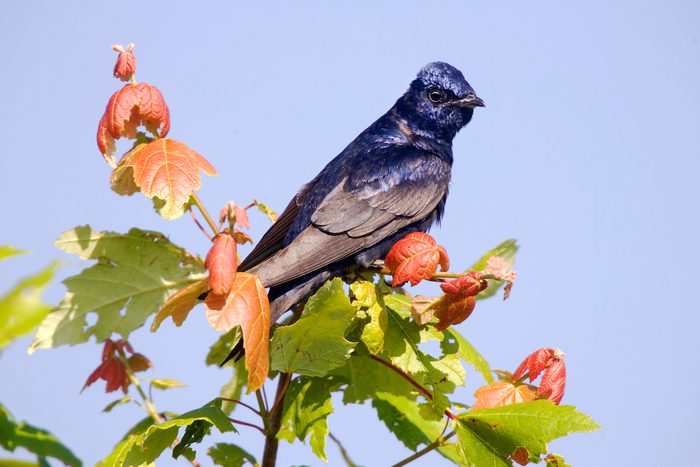
Just like monitoring bluebird houses, being a purple martin landlord takes time and commitment. In summer, boxes must be kept free of non-native house sparrows. In late fall, boxes must be cleaned and closed. But it’s all worth the effort. Hosting purple martins means you’ll get to enjoy these feathered good neighbors during spring and summer before they fly the coop in fall.
Do purple martins eat mosquitoes? Here’s what you should know.
Inside a purple martin house, the nest is a cup of grass, leaves, twigs, miscellaneous debris and usually some mud. Learn more about swallows nests and nesting habits.
“Purple martin houses are a hub of activity. It’s fascinating to watch purple martins come and go. I love to watch for the youngsters poking their heads out of the boxes,” says naturalist and nature writer Ken Keffer.
Next, learn how to identify and attract a tree swallow.
Why Trust Us
For nearly 30 years, Birds & Blooms, a Trusted Media Brand, has been inspiring readers to have a lifelong love of birding, gardening and nature. We are the #1 bird and garden magazine in North America and a trusted online resource for over 15 million outdoor enthusiasts annually. Our library of thousands of informative articles and how-tos has been written by trusted journalists and fact-checked by bird and garden experts for accuracy. In addition to our staff of experienced gardeners and bird-watchers, we hire individuals who have years of education and hands-on experience with birding, bird feeding, gardening, butterflies, bugs and more. Learn more about Birds & Blooms, our field editor program, and our submission guidelines.
Sources
- purplemartin.org, the website of the Purple Martin Conservation Association
- Kenn and Kimberly Kaufman, official birding experts for Birds & Blooms
- Ken Keffer, naturalist and author
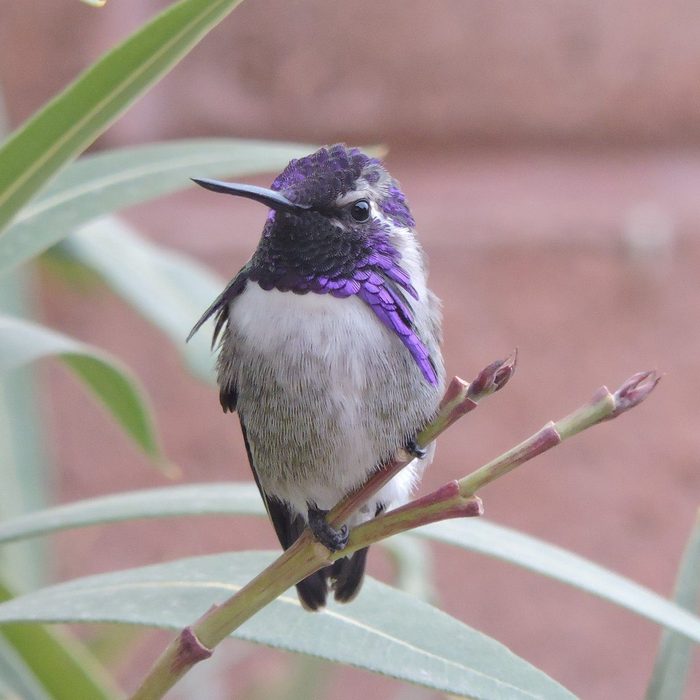
Hummingbirds are tiny marvels of nature, fascinating us every time they flutter by. Chalk it up to the speed at which their long, thin tongues draw nectar from flowers (up to 13 times per second) or to their ability to use their sturdy tail feathers to make hairpin turns. Still, one of the most interesting aspects of hummingbirds is not apparent to the naked eye. In fact, it was realized only in the last few years. A recent study published by the National Academy of Sciences called “Wild Hummingbirds Discriminate Nonspectral Colors” suggests that hummingbird eyes see the world in a range of brilliant colors, of which humans can only dream.
On This Page
Science of Hummingbird Eyes
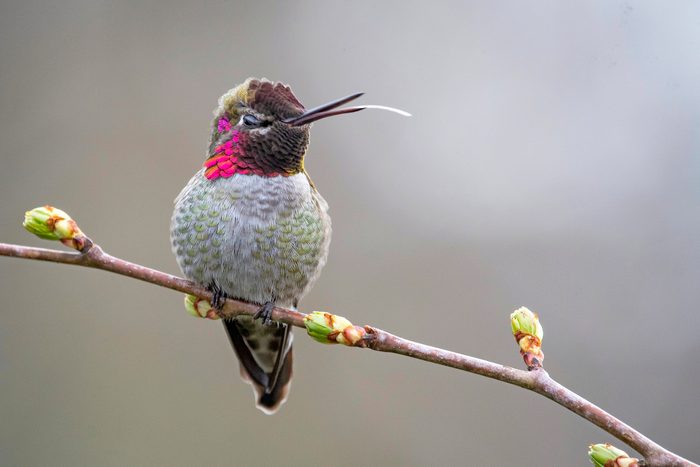
A hummingbird’s relatively large eyes are wired to pick up many more hues than human eyes can see. Hummingbird retinas possess four types of cones, while humans have only three that detect blue, green and red tones. The fourth type of cone that hummingbird eyes have is sensitive to ultraviolet light, which people cannot see. And when the ultraviolet hues blend with ones that humans can perceive, new colors appear.
Of all the colors in the rainbow, hummingbirds love the color red, and for a very good reason: Their retinas have a more dense concentration of cones, which mutes cooler shades like blue and heightens warmer shades like red and yellow. It’s fascinating how a small creature can have such intricate anatomy.
How Hummingbirds Use Their Keen Eyesight
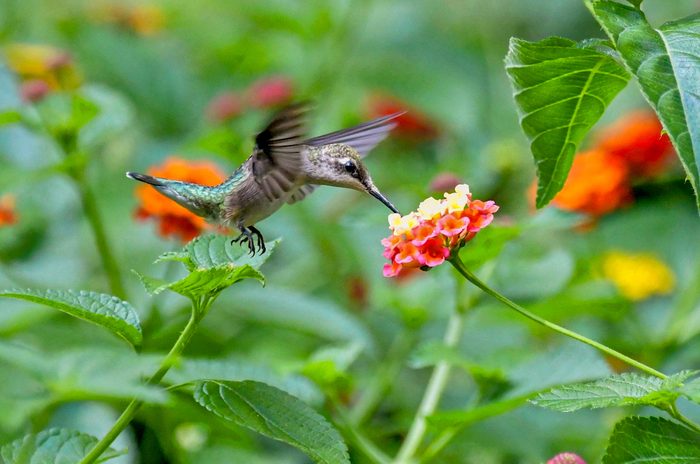
Having expansive vision helps hummers do a variety of tasks, including finding mates and spotting food sources. And this is especially true when it comes to locating flowers that hold their life-sustaining nectar.
If you’re looking to attract hummingbirds to your yard, plant colorful flowers like phlox, hollyhock, foxglove and lantana. Remember, hummingbirds love the color red, so the more red you can get blooming, the faster a few new friends may be drawn in.
The next time you see a jeweled wonder fly by, take a moment to not only to welcome the visitor with an array of appealing nectar sources but to appreciate and imagine the spectacular colors that it recognizes out in nature.
What makes hummingbird feathers so shimmery?
Field Test
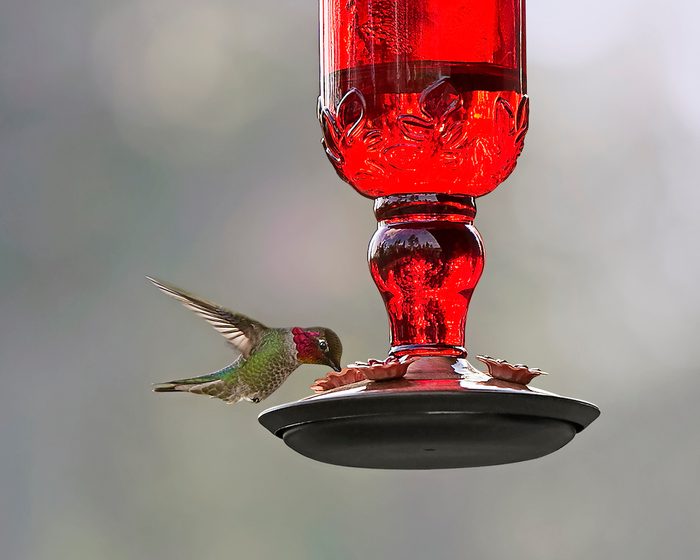
Here’s how the researchers proved their ultraviolet theory.
The scientists performed outdoor experiments with wild hummingbirds to test how well they see different ultraviolet colors. They engineered special LED tubes that emitted several colors, both on the visible and ultraviolet (UV) spectrum. They placed the LED tubes next to two feeders. The one with plain water did not give off ultraviolet rays and another with sugar water did give off UV light.
They trained hummingbirds to associate the UV light with the reward of sugar water and regular light with plain water. When scientists rearranged the placement of the feeders, similar to the Pavlovian dog experiment, the hummingbirds were still more quickly drawn to the feeder giving off ultraviolet light—which proved that the birds could tell the difference between the one emitting the special rays and the normal feeder.
The hummingbird heart rate is unbelievably fast.
Do Your Own Experiments
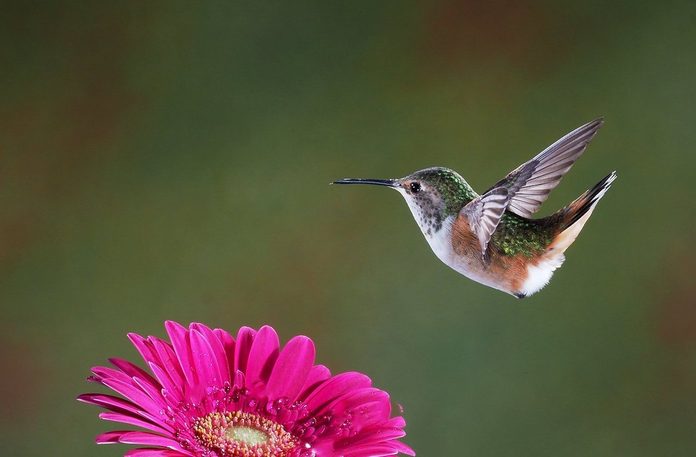
Citizen science projects such as eBird, Backyard Bird Count and NestWatch are looking for birders and gardeners to provide valuable data for researchers. Visit their websites to look up opportunities and see how you can lend a scientific helping hand.
How fast do hummingbirds fly and flap their wings?
- Additional reporting by Kelly Aiglon
- Reviewed by birding experts Kenn and Kimberly Kaufman
Why Trust Us
For nearly 30 years, Birds & Blooms, a Trusted Media Brand, has been inspiring readers to have a lifelong love of birding, gardening and nature. We are the #1 bird and garden magazine in North America and a trusted online resource for over 15 million outdoor enthusiasts annually. Our library of thousands of informative articles and how-tos has been written by trusted journalists and fact-checked by bird and garden experts for accuracy. In addition to our staff of experienced gardeners and bird-watchers, we hire individuals who have years of education and hands-on experience with birding, bird feeding, gardening, butterflies, bugs and more. Learn more about Birds & Blooms, our field editor program, and our submission guidelines.
Sources
- National Academy of Sciences of the United States
- National Geographic
On This Page
Why You Should Add Nicotiana to the Garden
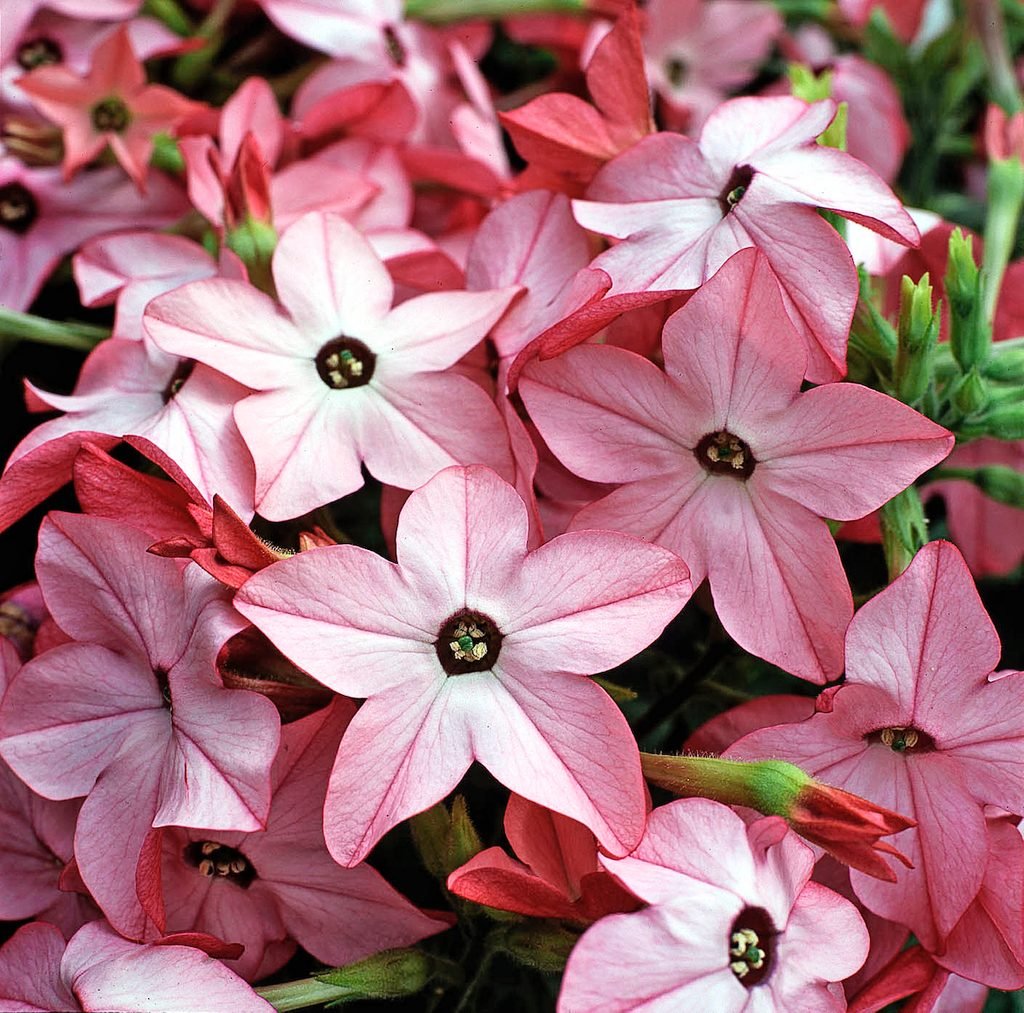
If you want to create an inviting space for hummingbirds to visit in your yard, nicotiana will entice them with tube-shaped flowers and plentiful nectar. This cottage garden favorite, also known as flowering tobacco, is an easygoing plant that will provide color and fragrance all summer long.
Barbara Pierson, horticulturist and nursery manager of White Flower Farm in Litchfield, Connecticut, says, “We love growing nicotiana in the garden because they are practically carefree. No fussy watering or soil requirements and the free branching habit requires no staking. They like a sunny spot, but I have found that part shade can work, and the flowers tend to hold better with a little shade.”
Nicotiana Care and Growing Tips
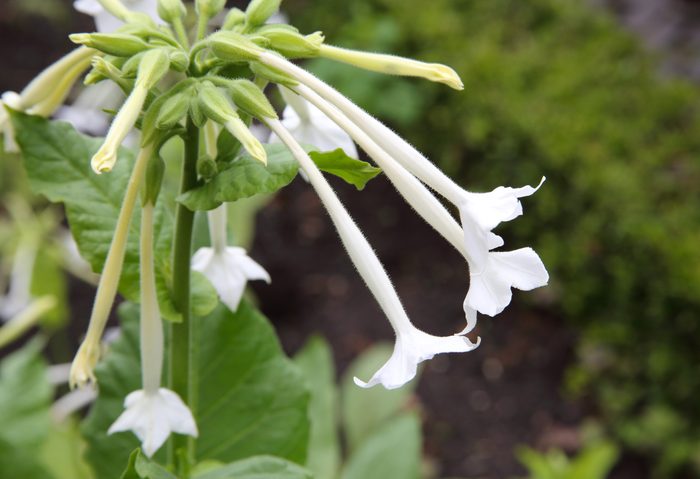
- Scientific name: Nicotiana spp.
- Common name: Flowering tobacco
- Zones: 10 to 11 or annual
- Light needs: Full sun to partial sun
- Size: 1 to 5 feet tall
These plants like to be in well-drained soil and full to partial sun. You can start seeds indoors several weeks before the last frost date or look for plants at your favorite garden center.
Nicotiana is hardy in USDA plant zones 10 and 11, or treat it as an annual. If you don’t remove spent flowers, you may get a few volunteer seedlings next year.
‘Towards the end of the growing season here in Connecticut, we allow them to produce as much seed as possible so that we have seedlings the following summer,” says Barbara. “Plants that self sow are welcome surprises in spring!”
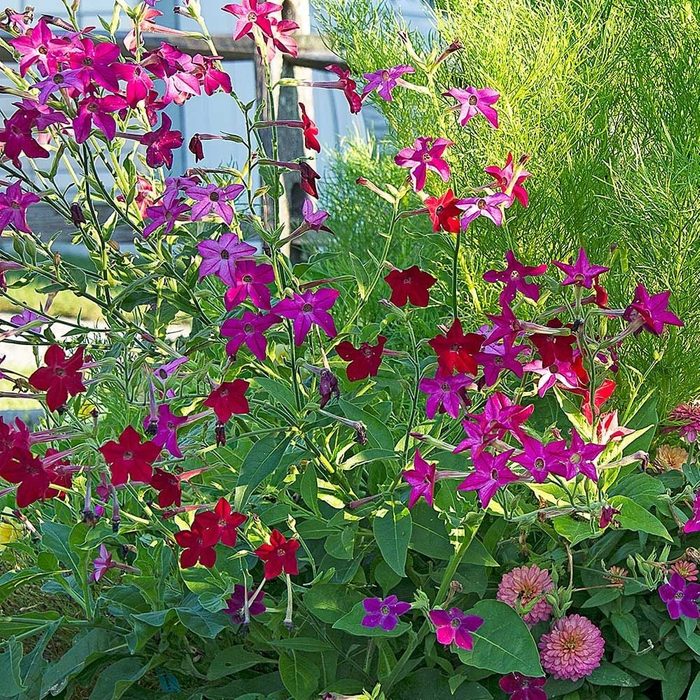
To keep the plants looking their best, keep up with watering during hot weather. This is especially important for container-grown plants, which dry out faster.
“Keeping your plants healthy by watering when needed will ensure flower production and hummingbird visits through the summer. Nicotiana will wilt slightly, so knowing when to water can be done by observing the plants during hot sunny stretches of weather,” says Barbara.
Where to Plant Nicotiana
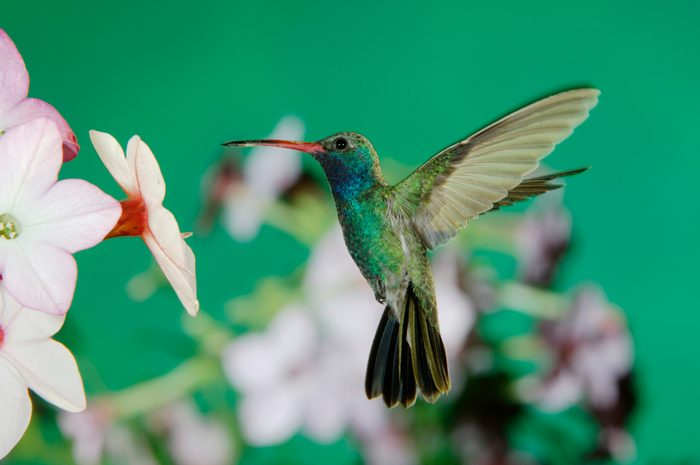
“Nicotiana comes in a variety of sizes,” says Jen McGuinness, author of Bird-Friendly Gardening: Guidance and Projects for Supporting Birds in Your Landscape.” Tall varieties can be incorporated into the back of the garden, while the smaller, more compact plants can be grouped together in the front of a border or used in container plantings. Consider planting nicotiana with other flowers that attract hummingbirds, such as wild bergamot (Monarda fistulosa) and butterfly weed (Asclepias tuberosa).”
Barbara suggests using nicotiana both in the garden and in pots. “The large stature (taller) varieties are best grown in the garden. They can be grown in pots if the container is large enough. The shorter varieties can be grown in the garden or in pots on a patio. If you choose to grow them in pots to attract hummingbirds to your deck, remember that they do take more water when pot grown. I have done this successfully at home and love watching the hummingbirds visiting the tubular flowers.”
Fragrant Floral Scent
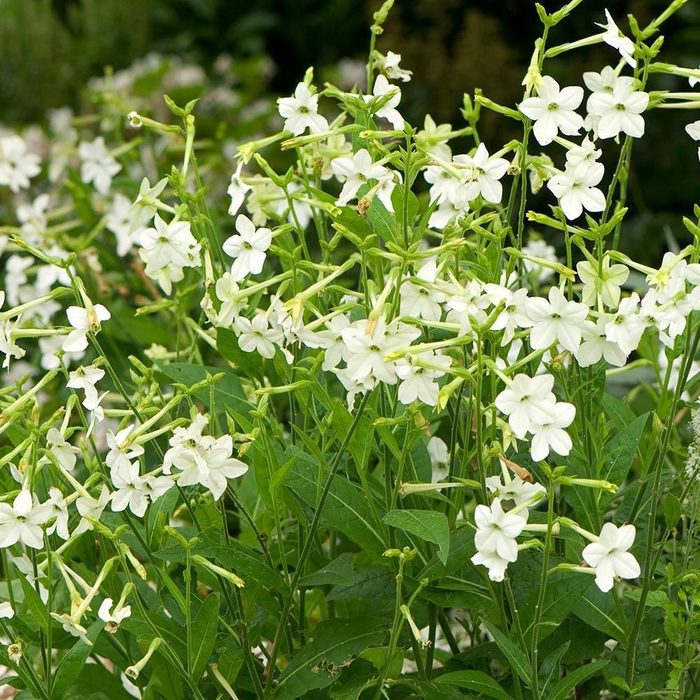
In addition to adding graceful structure to plantings, nicotiana offers a lovely scent that carries through the yard and garden. The tubular-shaped flowers appear on branched stems during summer to provide color and fragrance all season long and into fall.
Nicotiana is known for a perfume fragrance that starts to linger at dusk and into the evening. The flowers smell sweetest after dark. For an intoxicating scent, try Nicotiana alata. The white flowers will illuminate a moon garden.
Best Nicotiana Varieties
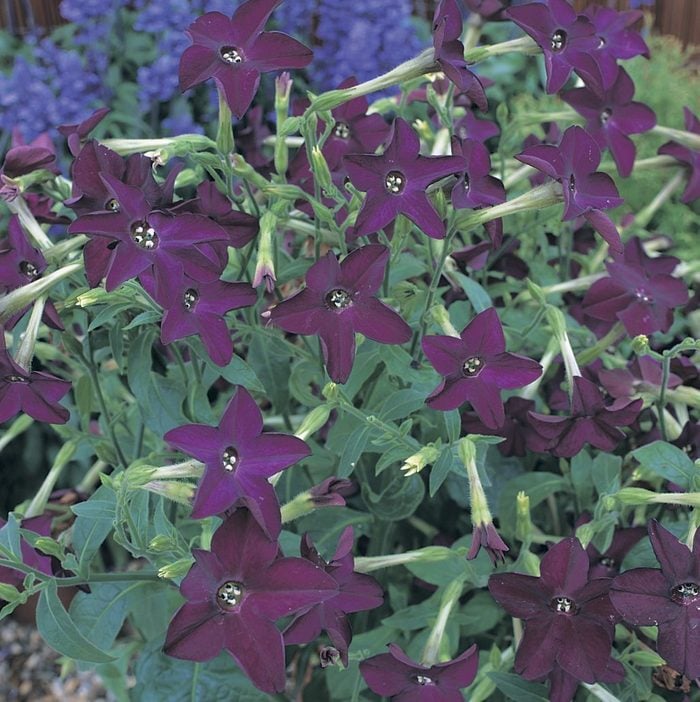
Nicotiana blooms can be found in a range of colors, including white, rose, lime green and purple. Barbara suggests using ‘Perfume Deep Purple,’ an All-America Selections winner that can be grown in the ground, raised beds or pots. “I love the dark purple color with older flowers fading to lavender and fragrance of this variety. It can also be grown in part shade.”
Nicotiana alata is a popular white variety that has been grown for a very long time. “It is the standard white flowering tobacco. ‘Crimson Bedder’ has red/magenta flowers that really put on a show all summer on a fairly large plant. Hummingbirds love the number of flowers and I like the color,” Barbara says.
Another standout cultivar choice with many gardeners is ‘Only the Lonely.’ The name refers to the size of this nicotiana— it’s so tall in stature that it stands out from all other plantings in a garden space.
Attract Hummingbirds with Nicotiana
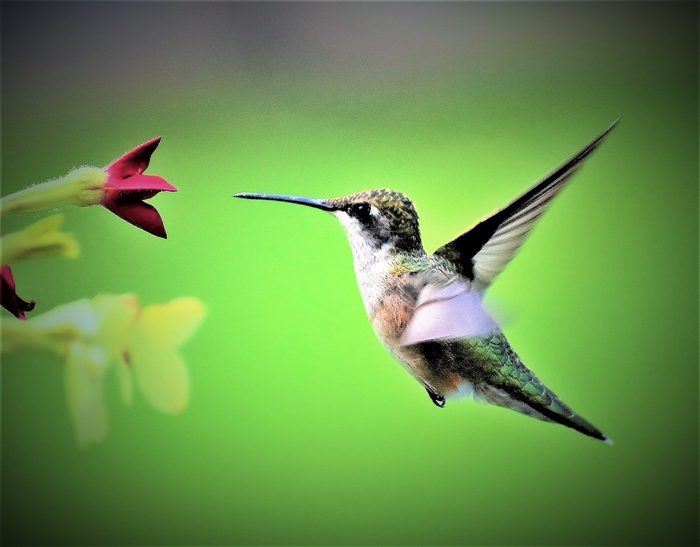
Nicotiana provides a welcome invitation for hummingbirds to the garden.
“Hummingbirds like nicotiana because the flowers are tubular and have nectar that the birds enjoy,” says Barbara. “Nicotiana is so free flowering that there are many flowers open at a time for feeding. Moths also are attracted to nicotiana; I enjoy seeing (them) in the late afternoon and evening.”
Adding nectar rich flowering tobacco plants to your healthy garden can tantalize hungry hummingbirds to join the butterflies and bumblebees at your blossoming buffet.
“Hummingbirds need a lot of energy.” says Ben Young III, urban naturalist and host of “Wild New York” on YouTube, “Their hearts beat up to 1,200 times a minute! When they’re foraging for nectar, a one-stop-shop like Nicotiana alata have blooms in bunches, meaning a hummingbird can gather quite a bit of nectar without flying too far.”
Why Trust Us
For nearly 30 years, Birds & Blooms, a Trusted Media Brand, has been inspiring readers to have a lifelong love of birding, gardening and nature. We are the #1 bird and garden magazine in North America and a trusted online resource for over 15 million outdoor enthusiasts annually. Our library of thousands of informative articles and how-tos has been written by trusted journalists and fact-checked by bird and garden experts for accuracy. In addition to our staff of experienced gardeners and bird-watchers, we hire individuals who have years of education and hands-on experience with birding, bird feeding, gardening, butterflies, bugs and more. Learn more about Birds & Blooms, our field editor program, and our submission guidelines.
Sources
- Barbara Pierson, horticulturalist and nursery manager at White Flower Farm
- Jen McGuinness, author, Bird-Friendly Gardening: Guidance and Projects for Supporting Birds in Your Landscape, available March 19, 2024
- Ben Young III, urban naturalist and host of Wild New York on YouTube
- Cornell Cooperative Extension
- New York Botanical Garden
- Missouri Botanical Garden
- All-America Selections
On This Page
Columbine Flower Care and Growing Tips
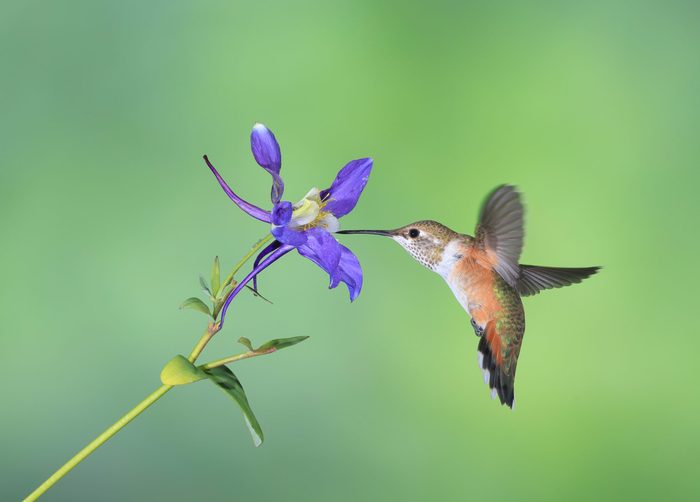
- Scientific name: Aquilegia
- Common name: Columbine or granny’s bonnet
- Zones: 3 to 8
- Light needs: Partial shade to partial sun
- Size: 2 to 3 feet tall
Columbine (Aquilegia) is the name of a genus of multi-colored flowers that bloom in the spring and are loved by gardeners for how easy they are to maintain. A columbine flower is a perennial plant, which means it comes back every year instead of dying off after a single growing season. You may also know it by its nickname, granny’s bonnet, a nod to its bell-shaped blossoms that are so heavy, they cause the stems to droop.
Hardy in Zones 3 to 8, columbine reaches 2 to 3 feet tall in good growing conditions. Identify it by its thin stems and five round-petaled blooms that are framed by sepals or spurred petals, creating a colorful, two-toned look. The foliage is a lush green with rounded or heart-shaped leaves, making it a handsome plant even after the blooms have fallen off.
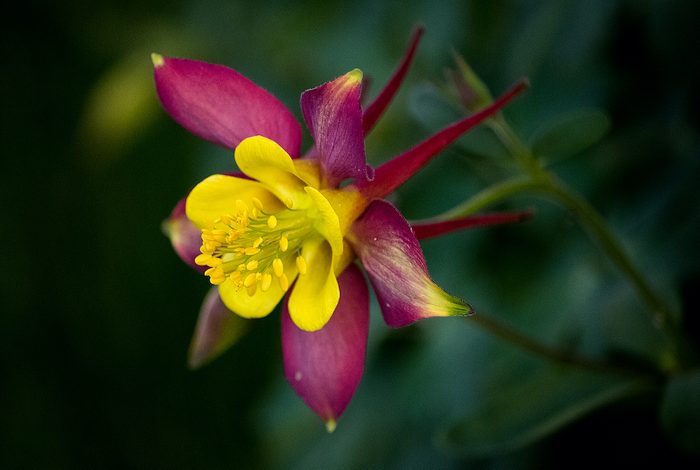
Although columbine isn’t fussy about its growing conditions, there are some things to keep in mind. It grows best in partial shade but will tolerate full sun, especially in cooler climates.
Columbine prefers well-draining soil with neutral to slightly acidic Ph levels. Most varieties are drought-tolerant, making it a good choice for rock gardens. Established plants only need watering about once a week—but make sure not to drench them. Regarding fertilizer, note that too much nitrogen puts a damper on their blooms.
Check out more of the best perennials to grow for hummingbirds.
Are Columbines Native Wildflowers?
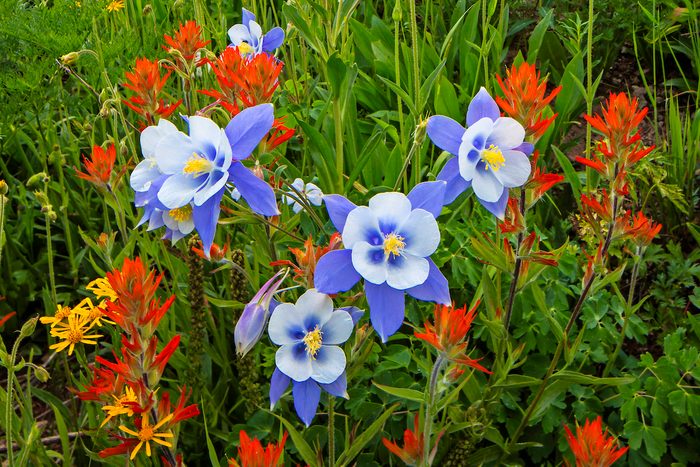
Plant enthusiasts best know columbine as a native wildflower, though of course, it can be grown in gardens and backyards— often with or without human help. Colorado’s state flower, the Colorado blue columbine, is a descendant of one of the earliest native columbines in North America. Another well-known wildflower species is Eastern red columbine, native to most states east of the Rockies.
These days, there are about 70 columbine flower species and counting. Columbine propagate and cross-pollinate easily, so it’s not unusual for new hybrids to hit garden shops every year.
A couple cultivars to try include the Kirigami series (the blooms tilt up for a bigger wow factor) and Black Barlow (the dark petals amp up the drama).
When and Where to Plant Columbine
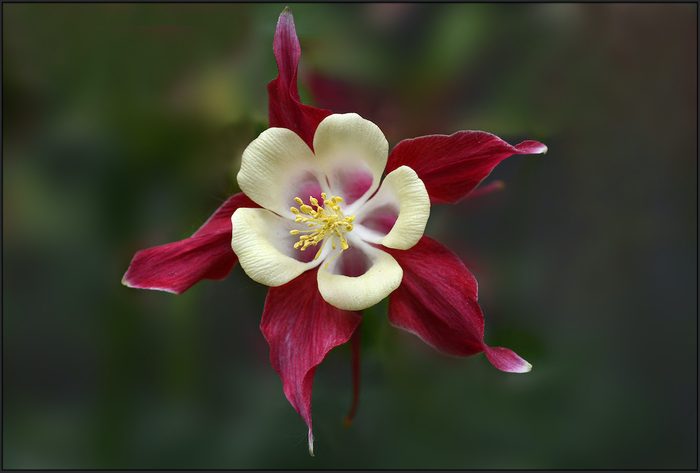
Columbine are spring blooming flowers, so one of the best times to introduce them to your garden is in autumn. No need to get the trowel out for columbine—most gardeners direct sow the seeds by simply pressing them into the soil. They need sunlight to germinate, so you don’t want to bury them. Once established, columbine readily self-seeds and produces more seedlings on its own.
You can also direct-sow seeds outdoors in early spring or start seeds indoors in mid- to late winter. Note that columbine seeds germinate best if chilled at 40 degrees for a few weeks. This cold period is known as known as stratification.
Around 30 to 90 days after planting, you’ll have seedlings that should be watered frequently to maintain moisture. Just don’t go overboard and drown them. Transplant indoor-grown seedlings to your garden after the last spring frost.
Columbine adds pops of color in-between the last spring bulbs and the first summer flowers. Deadhead spent blooms to encourage additional flowering. Gardeners like to use columbine in borders and beds but it can also be grown in containers if you’d prefer to more strictly control its spread. Many container-bound columbine are hardy enough to come back in spring.
Columbine Pests and Diseases
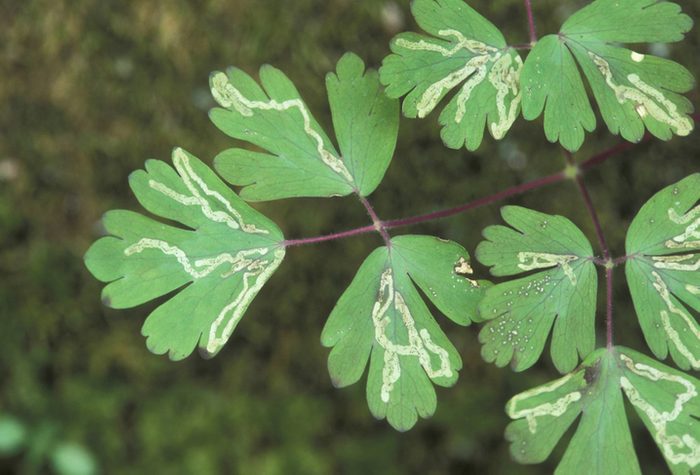
Because columbine is a native perennial, it’s a really hardy plant but it can sometimes encounter issues, too. Pests like columbine leafminer attack by damaging the foliage as they feed until maturity. The adult flies are hard to spot but if you see squiggly stripes on foliage, you probably have a leafminer problem. Their larvae overwinter in the ground, so turning up the soil may help control their population. Removing infected leaves is a good idea, too. Luckily, leafminers only affect how the plant looks and won’t destroy it.
Do Columbine Flowers Attract Hummingbirds?
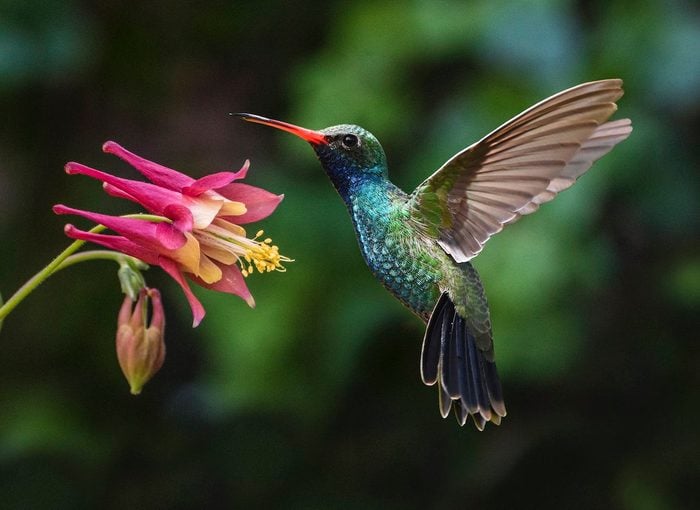
The biggest motivator for bringing columbine into your landscape is for all the hummingbirds and backyard pollinators it attracts. Hummingbirds especially love it because of the flowers’ tubular shape. Another bonus? The blooming season is perfectly timed for when hummingbirds are returning and looking for a major energy boost.
Hummingbirds will stop at any color of flower but they especially love warm hues, so red or pink columbine are your best bet for attracting them. Butterflies, moths and bumblebees love the nectar-rich blooms, too.
Why Trust Us
For nearly 30 years, Birds & Blooms, a Trusted Media Brand, has been inspiring readers to have a lifelong love of birding, gardening and nature. We are the #1 bird and garden magazine in North America and a trusted online resource for over 15 million outdoor enthusiasts annually. Our library of thousands of informative articles and how-tos has been written by trusted journalists and fact-checked by bird and garden experts for accuracy. In addition to our staff of experienced gardeners and bird-watchers, we hire individuals who have years of education and hands-on experience with birding, bird feeding, gardening, butterflies, bugs and more. Learn more about Birds & Blooms, our field editor program, and our submission guidelines.
Sources
- University of Wisconsin-Madison Division of Extension
- The Connecticut Agricultural Experiment Station
- New York Botanical Garden
- Monrovia
- Utah State University Extension
- Britannica
- United States Department of Agriculture
- Virginia Cooperative Extension
- The National Gardening Association
On This Page
Fuchsia Plant Care and Growing Tips
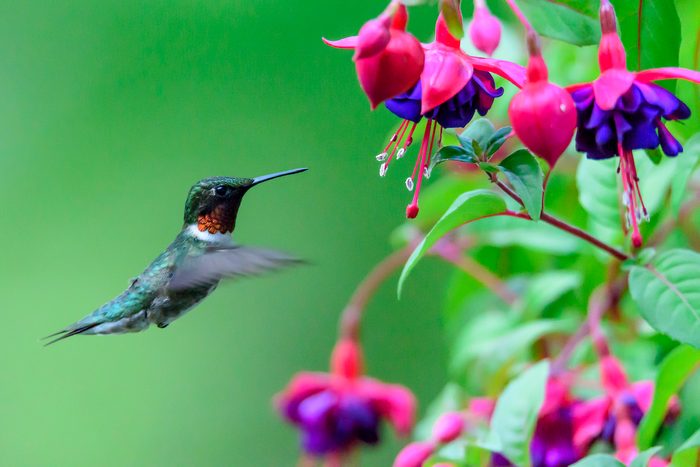
- Scientific name: Fuchsia spp.
- Common names: Fuchsia, lady’s eardrops, hardy fuchsia, hummingbird fuchsia
- Light needs: Shade to Part Shade
- Hardiness zones: 10 to 11 or annual
- Size: 10 to 24 inches tall
- Benefits: Attracts hummingbirds, birds, butterflies and moths
Fuchsias are summer flowering plants with colorful, pendulous blossoms. Hummingbirds are attracted to the flowers’ bright colors. Their long tongues have adapted to access the high amount of nectar.
Fuchsias are perennial plants in zones 10 and 11, but most are not winter hardy so you can treat them as annuals or overwinter them as houseplants. Many have a trailing habit, perfect for hanging baskets and containers. The upright forms can be trained as standards (tree or lollipop shape) or as small shrubs.
Although there are a few with variegated foliage, most plants have 2- to 4-inch long, green, oval shaped leaves. The plant blooms from summer to frost and the blossoms appear in pairs on 1- to 2-inch thin stems.
Blossoms can be narrow and tubular like trumpets or ornate like a lady’s earring. The ornate ones have reflexing sepals (the outermost part), a bell-shaped corolla (the petals), protruding long stamens, and a very long pistil. Often, the arching sepals are a different color than the bell-shaped corolla.
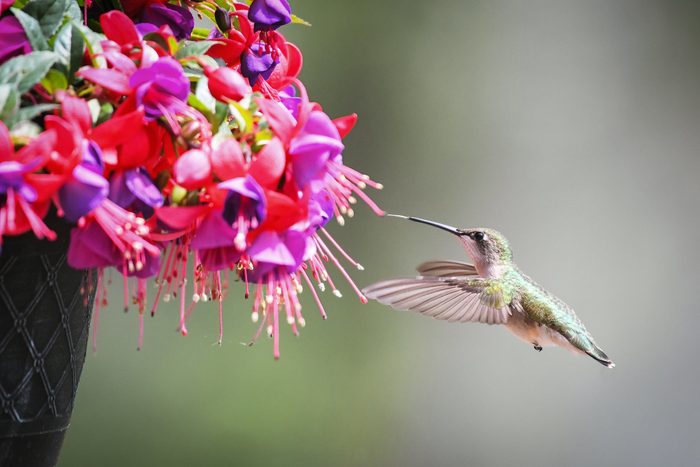
There is a wide range of flower colors—red, pink, purple, orange, magenta, salmon, white—and color combinations. There also are double flowered types, creating a ruffled appearance.
The plants prefer moist, well-drained soil, high in organic matter. They tolerate shade well. To encourage continuous blooms, fertilize with one that is especially formulated for blooms.
Fuchsia Plant Problems
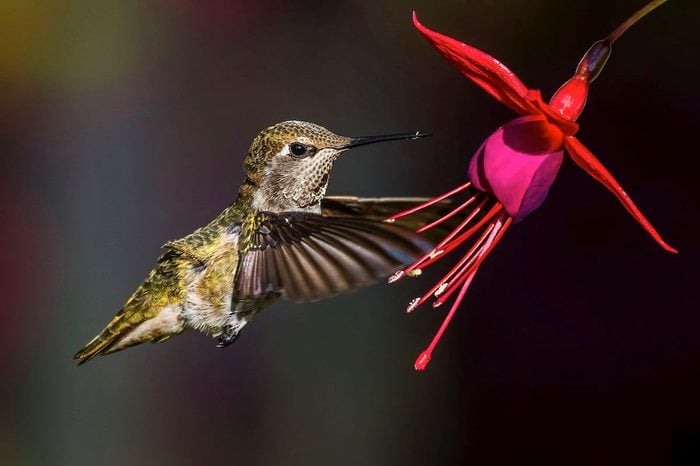
Most fuchsias are not winter hardy, but they are not heat lovers either. They thrive in cool summers with day temperatures of 60 to 70 degrees, dropping 10 degrees at night. They do very well in the Pacific Northwest but in areas with hot summers, they will stop flowering when temperatures climb above 70 degrees. It is unlikely the plants will die, but no flowers means no hummingbirds. Gardeners who live in hot areas should purchase heat tolerant varieties and place their plants in the shade.
Learn how you can help hummingbirds in extremely hot weather.
Propagating Fuchsia Plants
Fuchsias can be propagated by softwood cuttings. In early summer, take a 6-inch stem cutting, remove the lower leaves, and dip the cut end in a rooting hormone. Place in small, 4-inch plastic container with drainage holes. Moisten the potting mix and cover with a plastic bag. Place in the shade, in a warm spot. The cutting should take about a month to root.
Learn how to attract hummingbirds to a small garden.
Overwintering Fuchsia
To overwinter plants, bring them in before frost, trim down to 6 inches. and place in a cool, dark area. They will become dormant, drop their leaves, and require no water (unless completely dry). In the spring, move to a warm, bright area in the house and resume watering. After frost has past, move the plants outside and repot with fresh potting mix.
Check out the top 10 annuals that attract hummingbirds.
Recommended Fuchsia Varieties
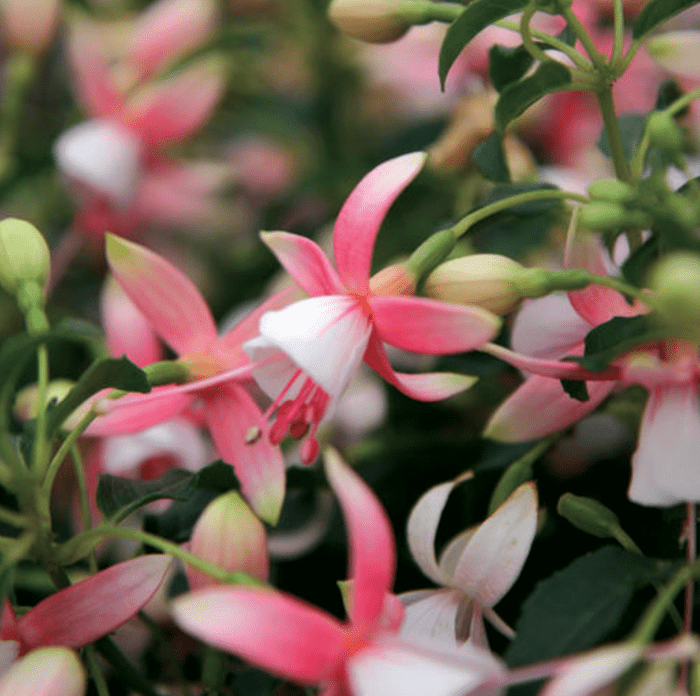
For heat tolerance, try hybrids with F. triphylla parentage such as “Billy Green” (slender tubular pink flowers) and “Gartenmeister Bonstedt” (slender tubular orange flowers with bronze-green foliage and red-purple veins). Also, check out Suntory Flowers’ Angel Earrings series, which were specifically bred for heat tolerance.
Although most fuchsias are hardy to zones 10 and 11, there is one species hardy to zones 6 and 7. Hardy fuchsia, F. magellanica, has long tubular blossoms in shades of purple and pink and can be grown as a deciduous shrub. When shopping for cold hardy fuchsias, look for hybrids with F. magellanica parentage such as “Riccartonii” (purple and red blossoms).
For variegated foliage, try “Gartenmeister Bonstedt” mentioned above, or “Firecracker” (variegated cream and green with purple veins), or “Autumnale” (yellow to coppery orange foliage).
For small containers, check out Proven Winners’ line of compact plants called Shadow Dancers: Betty, Yolanda, Rosella, and Violette. These upright plants grow to 8 to 12 inches tall.
Why Trust Us
For nearly 30 years, Birds & Blooms, a Trusted Media Brand, has been inspiring readers to have a lifelong love of birding, gardening and nature. We are the #1 bird and garden magazine in North America and a trusted online resource for over 15 million outdoor enthusiasts annually. Our library of thousands of informative articles and how-tos has been written by trusted journalists and fact-checked by bird and garden experts for accuracy. In addition to our staff of experienced gardeners and bird-watchers, we hire individuals who have years of education and hands-on experience with birding, bird feeding, gardening, butterflies, bugs and more. Learn more about Birds & Blooms, our field editor program, and our submission guidelines.
Sources
- Missouri Botanical Garden
- Clemson Cooperative Extension
- University of Washington Botanic Garden
- https://suntoryflowers.com/series/angel-earrings/
- Mendocino Coast Botanical Gardens
- Proven Winners
- PennState Extension
- Northwest Fuchsia Society
- https://www.beelife.org/do-fuchsias-attract-bees/
- https://www.hummingbirdsociety.org/hummingbird-flowers